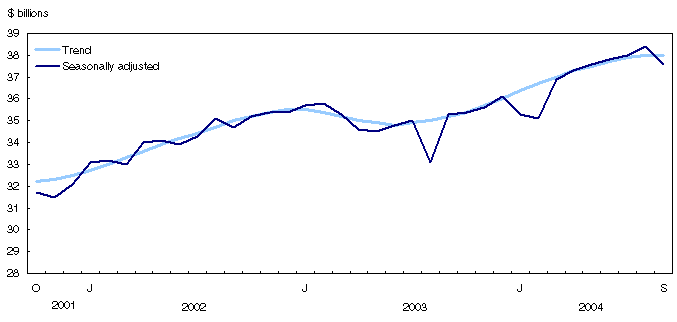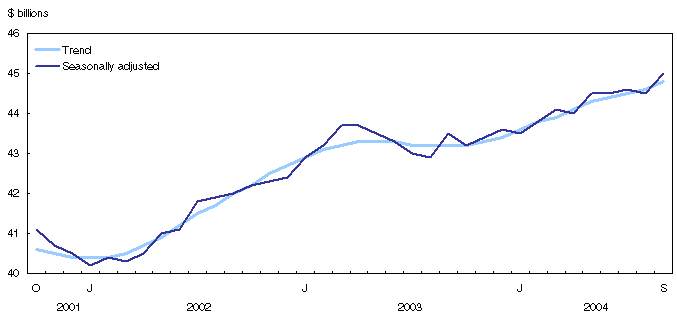
















 |
|
 |                |
Information identified as archived is provided for reference, research or recordkeeping purposes. It is not subject to the Government of Canada Web Standards and has not been altered or updated since it was archived. Please "contact us" to request a format other than those available.
| Wholesale trade
September 2004 Analysis — September 2004 Wholesale sales declined 1.9% in September to $37.6 billion, the first decrease in seven months. Excluding the automotive sector, total sales declined 1.3%. Despite this sizable drop, sales rose 1.0% in the third quarter compared with the second quarter. This gain follows a 5.1% increase in the second quarter. Moreover, cumulative sales for the first nine months of the year were up 6.3% compared with 2003. Since September 2003, total wholesale sales have generally been rising. Previously, sales went through a period of decline starting in March 2003. Chart 1

In September, sales slumped in five of the seven sectors. Among them were the "other products" category (-7.5%), which includes chemical products and other agricultural supplies; automotive products (-4.3%); and building materials (-0.9%). Increases were observed in two sectors: farm products (+6.1%) and personal and household goods (+1.1%). In constant dollars, wholesale sales slipped 0.9% in September, whereas for the first nine months of the year, they rose 7.2% compared with 2003. Automotive sector continues to suffer from weak Canadian consumer demand Wholesale sales of motor vehicles dropped 4.3%. Sales were also down by 3.7% for the quarter, partly owing to weak sales by Canadian auto dealers in recent months. Previously, sales went through a growth period that began in September 2003. Drop in housing starts affects the building materials sector Wholesalers of lumber and millwork reported a 3.2% drop in sales, due in part to a decrease in housing starts in both Canada and the United States in September. Rainy weather and the continuing threat of hurricanes in the United States slowed new housing starts. Despite two consecutive monthly declines, quarterly wholesale sales advanced for a fifth straight quarter with a gain of 4.2%. Historically low mortgage rates in both Canada and the United States boosted housing construction. Wholesalers of metal products saw their sales fall 1.5%. However, this decrease masks a solid third-quarter performance. Quarterly sales rose 12.0%, on the heels of another quite respectable increase of 9.6% in the second quarter. These strong gains are explained in part by the high prices of some products. The increase in prices is mainly due to robust demand for these products in China, which now accounts for more than 20% of global demand for metal products. Another factor that could explain the lower sales of several wholesalers, namely "other products," metal products and lumber and millwork, is the stronger Canadian dollar. In September, the Canadian dollar appreciated approximately 2% against the US dollar. These groups obtain a sizable share of their sales from exports, and many of their products are denominated in US dollars. Sales rebound in the personal and household goods sector Following a 1.8% drop in August, sales in the personal and household goods sector rose 1.1% in September. This gain was propelled by apparel sales (+3.7%), which registered their first rise in four months. Sales of pharmaceuticals also rose (+0.7%). Sales in the personal and household goods sector reached an all-time high last April, capping a growth spurt that began in February 2003. In the last few months, however, sales of this group have begun to show signs of weakness. Newfoundland and Labrador and Ontario post the steepest declines Wholesalers in Newfoundland and Labrador registered a third consecutive decline in sales, falling 6.0% in September. Contractions were observed in numerous trade groups, including food products and the "other products" group. Quarterly sales declined 9.5%, following a 5.2% increase in the second quarter. The groups that contributed the most to the weakness in quarterly sales were food products, machinery and equipment, and computers and electronic equipment. Sales of Ontario wholesalers also contracted in September (-3.4%). The drop is attributable to the automotive group and computers and electronic products. These two groups account for more than a third of the sales in this province. For the quarter, sales were down marginally (-0.2%). Wholesale sales in Ontario have generally been rising since September 2003 following a period of stability that began in February 2003. Inventory ratio up substantially An increase in inventories, combined with the decrease in sales, caused a rise in the inventory-to-sales ratio, which stood at 1.19 in September compared with 1.16 in August. Since September 2003, the ratio has followed a slight downward trend after a period of increases that began in December 2002. Chart 2

Inventories rose in September (+0.9%). An increase in inventories of motor vehicles and "other products" accounted for much of this gain. The value of inventories in these two sectors represents approximately 22% of total inventories of wholesalers. The trend in overall inventories has generally been upward since November 2003, following a five-month period when wholesalers reduced their inventories. Chart 3

|
|
|
|